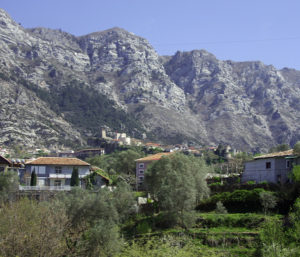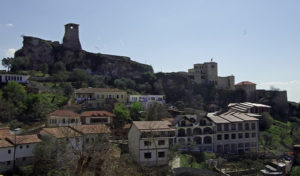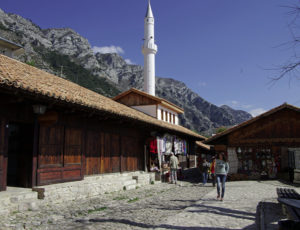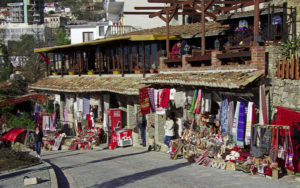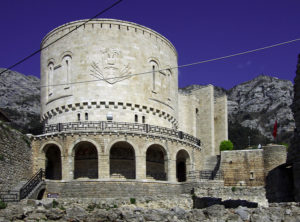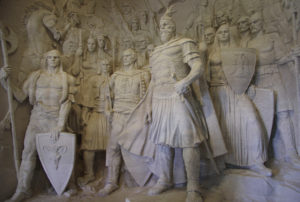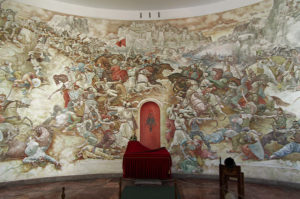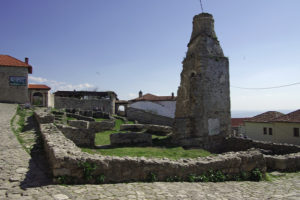Kruja is a small town in the mountains to the north of Tirana. The area has been fortified since ancient times and was the centre of resistance to C15th Ottoman invasion lead by Skanderbeg who was born in the town. It is the Skanderbeg connection which brings the tourists.
This was another fortified settlement like “Gjirokastra”:http://wasleys.org.uk/eleanor/otherholidays/albania/day_four/four_three/index.html and “Berat”:http://wasleys.org.uk/eleanor/otherholidays/albania/day_six/index.html
restored in the 1960s and the wooden shops and cobbled street have an authentic Ottoman feel. It sells everything from antiques to metal helmets to tourist souvenirs and silver jewellery. Be prepared to haggle.
The castle us surrounded by thick walls and entered through a small gateway. The inside is dominated by the massive Skanderbeg Museum which was opened in 1982. It is very much a shrine to a national hero and is very popular with Albanians. There is little information in English so the average visitor may leave not much wiser unless on a conducted tour. We had a local guide who did his best to enthuse us, but it was an uphill struggle. The acoustics of the building are not good and sound reverberates round the space making it difficult to hear what the guide is saying. There are very few places to sit and rest. Although there are signs everywhere banning photography we were told it was allowed but without flash.
As you enter there is a large diorama of Skanderbeg leading his troops into battle.
The ground floor rooms have displays from Illyrian, Roman and early Middle ages. There is a large mural showing the Roman fighting the Illyrians and examples of pottery from those times. The displays in the National Historical Museum in Tirana or the museum at “Apollonia”:http://wasleys.org.uk/eleanor/otherholidays/albania/day_five/five_five/index.html are much better. In the next room is a painting of Kruje in medieval times along with some icons.
The upper floors tell the story of Albania’s struggle against the Ottomans using maps, and paintings, like the massive ‘Endurance’ which is a generalised depiction of Skanderbeg’s battles over 25 years. In front on the red cloth are replicas of his helmet and sword. The originals are now in Austria.
On the upper floors are documents (untranslated) showing links Albania developed with other European countries in Skanderbeg’s time, focusing on his diplomatic efforts to rally support for the resistance as well as copies of all the books that have been written about Skanderbeg.
A door leads out onto a terrace with good views of the castle and surrounding area.
Apart from the house with the “Ethnographic Museum”:http://wasleys.org.uk/eleanor/otherholidays/albania/day_eight/eight_two/index.html which is well worth visiting and the remains of a minaret, little is left inside the castle. The rest was destroyed when the museum was built.
Kruja is a pleasant town and the old bazaar is a good place to buy souvenirs and holiday gifts. The Skanderbeg Museum however is a bit turgid and can be missed unless you are really ‘into’ Skanderbeg.
There are more pictures “here.”:http://wasleys.org.uk/eleanor/otherholidays/albania/day_eight/eight_one/index.html
